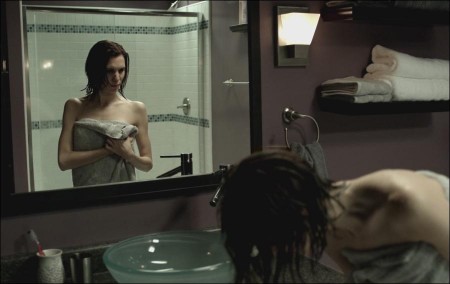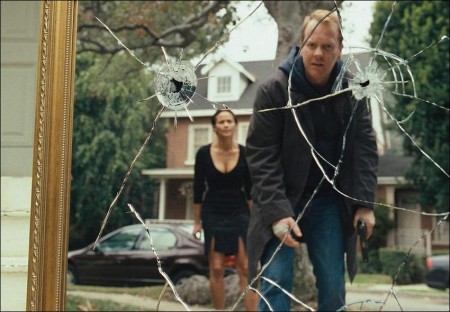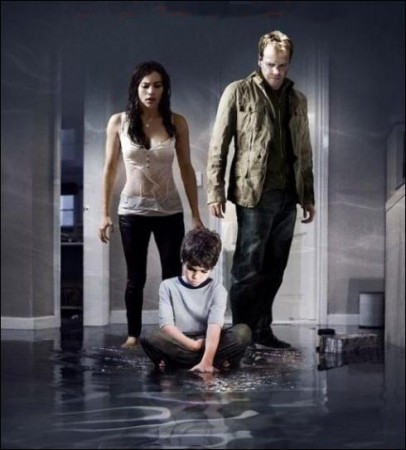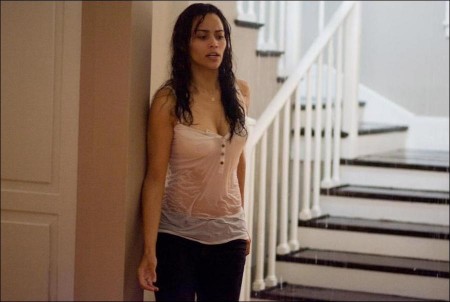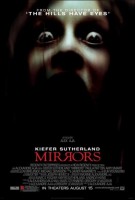Tagline: There is evil on the other side.
Mirrors is a 2008 remake of the 2003 South Korean horror film Into the Mirror, directed by Alexandre Aja and starring Kiefer Sutherland. Mirrors was first titled Into the Mirror, but later changed to Mirrors.
In a bid to pull his shattered life back together, troubled ex-cop Ben Carson (Kiefer Sutherland) takes a job as a security guard at the burned out ruins of a once-prosperous department store. As Ben patrols the charred hallways, he begins to see horrifying images in the ornate mirrors that still adorn the walls. Ben soon realizes that a malevolent force is using the mirrors to gain entrance into this world, threatening the lives of his wife (Paula Patton) and children.
From the director of “The Hills Have Eyes” comes “Mirrors,” the terrifying story of troubled ex-cop who must save his family from an unspeakable evil that is using mirrors as a gateway into their home.
Ben Carson (Kiefer Sutherland) has seen better days. It’s been nearly a year since the volatile detective was suspended from the NYPD for fatally shooting another undercover officer, an accident that not only cost him his job, but fueled the alcoholism and anger that has alienated his wife and kids and left him crashing on his sister’s couch in Queens.
Desperate to pull his life together and reconnect with his family, Carson takes a job as a night watchman at the burned-out ruins of the Mayflower department store. What once was a symbol of prosperity and grandeur now sits decaying in the darkness like a rotting ghost ship, destroyed by a massive fire that devoured numerous innocent lives. As Carson patrols the eerie, charred remains of the store, he begins to notice something sinister about the ornate mirrors that adorn the Mayflower walls. Reflected in the gigantic shimmering glass are horrific images that stun Carson.
Beyond projecting gruesome images of the past, the mirrors appear to be manipulating reality as well. When Carson sees his own reflection being tortured, he suffers the physical effects of his fractured visions. Suddenly the troubled ex-cop finds himself battling his personal demons and the ones that have hijacked his reflection, tormenting him with convulsions, spontaneous bleeding and near suffocation.
His sympathetic but skeptical sister Angela (Amy Smart) dismisses these bizarre “nightmares” as a consequence of his stress and guilt over the accidental shooting, but Carson’s estranged wife Amy (Paula Patton), a no-nonsense NYPD medical examiner, is less forgiving. Her husband’s increasingly erratic behavior frightens her, pushing his family farther away – and, she fears, it’s putting their children in danger.
But a much deadlier threat looms, trapped within the mirrors and reflective surfaces that pervade their everyday life. As Carson investigates the mysterious disappearance of a Mayflower security guard and its possible connection to his ghastly visions, he realizes that a malevolent, otherworldly force is using reflections as a gateway to terrorize him and his family. If he has any hope of saving his wife and children from a horrifying death, Carson must somehow uncover the truth behind the mirrors – and convince Amy to help him battle the greatest evil he has ever faced.
A New Fear Unleashed: Behind the World of “Mirrors”
From folklore to fairy tales, superstition to religious tradition – the mythology surrounding mirrors has always tended toward the dark. The Romans imbued mirrors with the power to reflect one’s soul and affect his or her well-being. This, coupled with their belief that life renews itself every seven years, led to the centuries-old legend that seven years of bad luck will follow anyone who breaks a mirror.’ In film and literature, mirrors serve as symbols of vanity and dangerous portals of truth or transport to another time and place. The Jewish faith calls for all mirrors to be shrouded in one’s home while mourning the passing of a loved one, lest the living be distracted by the trappings of beauty and the physical world.
But these cautionary tales of narcissism and bad luck pale in comparison to the most common phenomenon associated with mirrors: death. Steeped in cultures from Rome to the Far East is a common lore casting mirrors as malevolent entities that trap the souls of the living – thereby causing death – or imprison the souls of the departed before they can reach the afterlife, cursing their spirits to eternal captivity. (It is also said that a vampire cannot cast a reflection, because it is a creature of the undead and has already lost its soul.) That the association between mirrors and death has endured through generations and permeated societies around the globe speaks not only to man’s complex relationship with the Great Unknown, but also with his reflection.
“Mirrors inherently challenge us to look inside ourselves,” observes Kiefer Sutherland. “It’s difficult to look at yourself. It doesn’t matter how good-looking you may be. On a physical level and a spiritual one as well, it’s hard to face yourself in a mirror. Depending on what you see, they can be very frightening.”
The darkest elements of this collective mythology are re-imagined for the 21st century in “Mirrors,” the terrifying story of a troubled ex-cop who must defend his family from a savage evil that uses reflective surfaces as gateways to terrorize them. In developing the film, a remake of the 2003 South Korean horror movie “Into the Mirror,” for New Regency, producer Alexandra Milchan saw the potential for a multi¬layered psychological thriller in the tradition of “The Shining.”
“Beyond the horror aspect of the original film, there is something very universal and interesting about the cultural mystique of mirrors that provided the basis for a great dramatic piece,” says Milchan, the producer of such films as “Goodbye Lover” and “Righteous Kill.”
She approached writer-director Alexandre Aja (“The Hills Have Eyes,” “High Tension”) about bringing his bold style and visceral storytelling to the project.
“I was looking for a project that would allow me to explore fear in a new way,” says Aja, who established himself as a potent new voice in the horror genre with the hit French slasher film “High Tension” and “The Hills Have Eyes,” his grisly remake of the 1977 thriller about a family’s struggle to survive a brutal massacre by mutant cannibals.
At the core of “Into the Mirror,” the story of a detective who investigates a series of gruesome murders revolving around mirrors, Aja found what he was looking for. “Everyone has relationship with their reflection,” he muses. “It’s something we don’t really think about, but it’s there. Some people love to look at themselves in the mirror; others hate it. Mirrors can show us the traumas and truths that exist in our subconscious, and are just waiting to be revealed.”
Having previously explored the sadistic extremes of human nature, Aja relished the opportunity to delve into the supernatural. “The concept was really original, and I wanted to create a story around it that would make audiences confront themselves and their fears in a way they’ve never imagined,” he says.
Together with Gregory Levasseur, his co-writer on “High Tension” and “The Hills Have Eyes,” Aja crafted a chilling new narrative for “Mirrors,” rooting the story in a man’s struggle for redemption that begins as a quest to reunite his estranged family, and quickly escalates into a ferocious battle for their lives.
“Everything is collapsing around him,” Aja says of Ben Carson, an NYPD detective who has been suspended for the fatal accidental shooting of another undercover officer. “He’s lost his job. He’s lost his family. He’s lost his soul.”
Consumed by guilt and anger, Carson has further alienated his wife and young children with his alcoholism and volatile temper. “He’s at the lowest point of his life,” Sutherland says of the troubled cop, who has been separated from his family for months, crashing on his sister’s couch and clinging to sobriety by a thread.
It was the film’s hybrid of well-crafted horror and genuine family drama that spoke to Sutherland. “Alex told me a beautiful story,” recalls the Emmy and Golden Globe-winning actor, who first met with Aja to discuss the project after wrapping a long night of shooting his hit FOX TV series “24.” “Horror is a genre that has always intrigued me, but what attracted me to this story is that it deals with a family that is desperately trying to figure out how to come back together. It’s about second chances. In this incredibly drastic situation, a man finds his true self and reconnects with his family. When things are at their worst, he becomes his best.”
Based on that brief meeting with Aja – and before even screening “The Hills Have Eyes” – Sutherland agreed to do the film. “I’m a gambler,” he says. “I like to play cards, I’ll bet on which dog will hit the corner first, and I had a real strong sense in that meeting with Alex that we were going to do something special together. I had faith and I feel very lucky that I was right.”
There may have been another reason why Sutherland committed to “Mirrors” without first having seen Aja’s celebrated remake of “Hills.” “Scary films are very hard for me to watch,” he admits. “I took my daughter to see ‘Finding Nemo’ and when the shark comes in the boat, my popcorn went in the air. My daughter was ten at the time and she laughed at me for it.”
“I knew Alex and Kiefer would get along unbelievably well, because they’re both very direct and intense,” Milchan observes. “If you look at the body of Kiefer’s work, he always gives 150 percent. He’s very focused and authentic, and audiences love that about him.”
Sutherland brings his trademark intensity to the role of Ben Carson, a man on the brink of losing everything that matters to him. Broke and desperate to rebuild his life, Carson takes a job as the night watchman at the Mayflower Department Store… or what’s left of it.
Looming against the night sky like a tattered ghost ship run aground in a thriving city, the Mayflower was once a symbol of luxury and grandeur, until a fire ravaged the store and claimed many innocent lives in the process. Five years have passed since the blaze, with the Mayflower mired in a morass of legal battles that has left it to decay in the darkness, suspended in time like an eerie snapshot of life tragically interrupted.
As he patrols the burned-out ruins of the store, Carson catches fleeting glimpses of distorted images reflected in the enormous, ornate mirrors that line its walls. What he thinks are merely bizarre hallucinations soon intensify as the mirrors reveal shocking and grotesque visions of profound suffering.
The images are so powerful and explicit – people burning alive, incinerating flesh melting to the bone – Carson feels their effects as if he were being consumed by fire himself.
But Aja and Levasseur’s screenplay takes the original concept way beyond mirrors. What if a malicious force trapped within our reflections – any reflection, anywhere – could use them as conduits to terrorize the living? “The idea that a whole other world can be living on a different plane, stuck watching our world in reverse, is a very scary idea,” says Sutherland.
The fear factor is amplified exponentially as ordinary reflective surfaces like windows, water, TV screens, stainless steel façades and picture frames are transformed into deadly channels of evil. Suddenly, Ben finds himself not only battling his own demons – but the ones that have hijacked his reflection.
“The reflections represent what we could be capable of,” Sutherland says of their thematic duality. “Good or bad, they reflect ourselves at various extremes. And they can make us do things that we wish we couldn’t.”
MIRRORS uses the power we give to our own self-image as a springboard to explore our subconscious fears. “You can jail yourself in your own idea of who you are, and see things in your reflection that others don’t see – things that don’t really exist,” observes Paula Patton (“Hitch,” “Déjà Vu”), who plays Ben’s estranged wife Amy. “Like an anorexic who sees a fat person in the mirror, when in fact their reflection shows a very skinny person looking back at them. It speaks to our brains’ ability to create whatever image we want to see, so that mirrors are never really an accurate reflection of ourselves.”
Milchan sees apt social commentary in Aja and Levasseur’s exploration of the myriad reflective surfaces that exist in everyday life. “If you look at the architecture of Dubai, New York or Las Vegas, it’s all about glass, mirrors, shiny surfaces,” she says. “The mirrors and reflective surfaces in the film represent our culture, and its emphasis on narcissism and money. ‘I’m here, I’m in your face. Watch me.'”
“If what you’re running from is your own self-image, it’s impossible to avoid it in our society,” Sutherland concludes. “There are too many reflective surfaces. Just try it. Walk two blocks and try not to see yourself in a reflection off a window, or in a puddle of water. It’s impossible to do. That creates a sense of paranoia for Ben, which was fantastic to play as an actor.”
In real life, Sutherland does not like mirrors. “I have one in my bathroom and I think I have one in my closet just to make sure I’ve got the right socks on, but outside of that, I don’t like looking at myself very much,” he says. “It’s very odd to be looking at yourself all the time while you’re working. That was a very interesting aspect of making this film.”
When Carson investigates the mysterious death of a Mayflower security guard and its potential connection to the store’s menacing mirrors, the evil that has targeted him expands its focus to his family – and their modest New Jersey home becomes a virtual playground for the possessed reflection of his son Michael. “A lot of what happens in the store, he thinks is coming from his imagination,” says Sutherland. “When people get that depressed and they feel that low, they question their own sanity. Ben does that to a point, but the second his family is threatened, he becomes very clear.”
Carson’s sister Angela, played by Amy Smart (“Starsky & Hutch”), dismisses his waking nightmares as a consequence of his guilt and stress over the accidental shooting. But his increasingly erratic behavior alarms his wife, a no-nonsense NYPD medical examiner.
“She thinks he’s gone off his rocker,” says Patton, who started reading the “Mirrors” script one evening…and had to wait until morning to finish it. (“That was a good sign,” she cracks.) “Amy is very logical, very left-brained and scientific-minded, so the idea of ghosts or otherworldly forces is not something she believes in. She has also seen a lot of gruesome and horrible things in her line of work, so she doesn’t scare easily.”
At the same time, she notices that something is “off” with their son Michael, who seems preoccupied with his reflection. “Their family is crumbling,” Patton says, “and Ben feels more alone than ever because no one believes him.”
“There is a great balance between their two storylines,” notes Aja. “At the beginning of the film, Amy is the strong one, keeping what’s left of their family together while Ben is at rock bottom. As Ben finds the strength to confront himself and the evil force that’s terrorizing them, he and Amy must fight on separate fronts for the same purpose – saving the kids, themselves, and most important, their family.”
Ultimately, Aja strived to make “Mirrors” as provocative as it is entertaining. “I hope this film has a huge psychological effect on the audience,” Aja says. “I want them to wonder, ‘Am I going to ever look in the mirror again, or will I be too scared?’ The next time they see their reflection, they may have a strange feeling that they’re not alone.”
Will Sutherland be able to watch “Mirrors”? “Hopefully, I’ll be smart enough not to take popcorn with me, but if I do, it’s gonna go in the air,” he jokes. “We’ve created something truly frightening that will stay with you, that will touch a fear inside you that is real, and we’ve blended it with this family drama that is so important to me – the story of a man who is looking for a second chance. By bringing these two genres together, I think we’ve given this film a depth that not many horror films have.”
About the Production
Rife with suspense and rich with disquieting atmosphere, “Mirrors” is fortified by an evocative production design that portends the horrific journey that awaits Ben Carson and his family.
Mirrors was filmed almost entirely in Bucharest, Romania, with the exception of key exteriors, which were shot in New York. Bucharest was selected by the filmmakers because of its formidable Academy of Sciences building, a massive structure commissioned by oppressive Communist leader Nikolae Ceausescu, which was left unfinished following his death in 1989.
Writer-director Alexandre Aja envisioned the Academy as the setting for the ominous, fire-ravaged Mayflower department store. “This building is so phenomenal, it could not be recreated on a stage,” says Aja, who had visited the location several years ago while scouting for another film. “The atmosphere here is so filled with fear and tension, we knew we could capture something really unique.”
“Ceausescu frightened and traumatized more people than we’ll probably scare with this movie,” notes producer Alexandra Milchan. “You can feel the tension in this building. It still has his imprints on it.”
While the site easily lent its imposing scale and sinister history to the creation of the Mayflower set, production designer Joseph Nemec III (“The Hills Have Eyes,” “T2: Judgment Day”) and his art department faced major challenges in transforming 20,000 square feet of raw institutional architecture into the ruined opulence of a world-class department store.
From the grand staircase to the display cases, every aspect of the sprawling floor plan had to be designed, sculpted, fabricated and dressed in a mere 12 weeks – on the 6th floor of the abandoned Academy, which has no elevators.
This process included fire-torching every inch of the store that the fictitious blaze would have devoured. Two teams of torchers burned everything from walls, floors, furniture and draperies to a full compliment of the store’s “stock” – including clothing, watches, jewelry, housewares and cosmetics.
Particular attention was paid to the posing and decomposing of the mannequins, as a way of evoking the Mayflower’s former vitality and stature, as well as representing the evil that lurks within the store. “The mannequins give you a sense that there is some life left in this burned-out place,” Nemec explains. “We dressed them and put them in very lifelike positions, and then tried to burn and distress them in a way that underscores the tragedy of the lives that have been trapped behind the mirrors. One we called our David, because he held a very regal pose despite all the fabric around him being burned away. Another was called Freckles, because we torched its coating until it bubbled up, which symbolizes the emotions inside completely burning out.”
The strategic burning of the set was followed by a thorough dousing, courtesy of the “water team.” Painters then added layers of water “staining” to achieve the authentic look of a scorched structure that has been left to ruin by rain and neglect for five years. Additionally, wood shavings were burned and then blanketed throughout the set, creating a thick carpet of soot. The results were disturbingly realistic, both visually and aurally.
“There is a company in New York that supplies scents, everything from dirty socks to fresh roses,” says Nemec, who typically infuses his sets with aromas appropriate to each locale. “But in this case, I didn’t need to use them because we created a ‘burnt building smell’ ourselves!”
The dank, heavy odor and highly detailed authenticity of Nemec’s rotted-out set brought a unique texture and intensity to the production, according to Aja. “Shooting for weeks in the broken glass and dust, with the smell of smoke and fire hanging in the air, created an atmosphere for the actors and crew that made everyone feel how scary it would be to find yourself alone in this place, with only a flashlight to guide you through the darkness.”
“As an actor, when you come onto a set that is as real and pliable as this one is, there is an incredible amount of freedom,” says Kiefer Sutherland, who is accustomed to working within the confines of smaller scale environs on his hit television series “24.” “This set is 360 degrees, so if I want to do a full circle, if I want to move in this direction or that direction, I can. I don’t have to worry about a wall missing over here. It’s just fantastic.”
The scope of the set and the murky darkness that cloaks it presented a career challenge for cinematographer Maxime Alexandre (“The Hills Have Eyes”). “It’s definitely the biggest location I’ve ever lit, and it’s brimming with black walls,” he says, noting that the only sources of realistic natural light in the environment are the large windows at the store’s main entrance and the holes punched into the shattered panes of the dome roof by weather and time. “We used really high, strong lights to ‘un-stick’ silhouettes and objects from each other, and to create some depth of field and distance between the actors, the mirrors and their reflections.”
The ornate, 30-foot mirrors that adorn the Mayflower walls were positioned to amplify the magnitude of the space and reflect the horror, loss and desolation that pervade it. But from a practical standpoint, shooting a movie that revolves around mirrors is a filmmaker’s nightmare.
“When you’re a DP and you receive a script titled ‘Mirrors,’ it’s like a huge taboo,” Alexandre says. “Each frame is a gamble when you put the camera in front of a mirror. You’re always at the edge of your reflection.”
This was especially true of this production, as Aja and Alexandre went well beyond mirrors in crafting shots that capture reflections off an array of ordinary surfaces – windows, TV screens, stainless steel fixtures, picture frames, floors, water – each more complicated to film than the next.
“We knew from the beginning that it was going to be very difficult,” Aja acknowledges, “but I think we managed to use mirrors and reflective surfaces in a way that no one has ever done before.”
“Watching Alex pick up reflections off of everything was fascinating,” Sutherland enthuses. “He has incredible imagination. Every day I came to work, I saw something new. The story was revealing itself to me in a really fresh way.”
To facilitate the filming of scenes that involved flooding the Carson residence and picking up reflections in the water’s surface, Nemec’s team built the set for the modest home on a water tank, using double-curved fiberglass walls and sealed flooring that could be filled and drained as needed. (Nemec chose dark colors for the floors to intensify the reflective effect.) Removable sections of flooring were installed for a climactic sequence in which young Michael Carson is yanked through his reflection and disappears into a thin layer of water coating the floor.
As complex as it was to design a functional water set like the Carson house, Nemec found it equally taxing to make it look like a typical New Jersey family home. “Finding furniture and household objects in Bucharest, Romania that we could adapt to look like typical American décor was quite a challenge,” the designer reports.
Sutherland was impressed by his stay in the nascent country’s capital. “Romania may be a young country from our perspective, but you’re talking about one of the most well-educated societies in the world, with a 97% literacy rate,” he notes. “There are five year-olds running around who can kick my ass in chess. You have incredible writers and filmmakers here. Romania just won the Palme d’Or at Cannes, and joined the European Union. Yet it’s struggling to find its new identity. It’s going through a massive transition, politically and economically. It’s a very exciting time here. Did that affect the process of making the film? Absolutely.”
Like their efforts to capture reflections in a new and exciting way, the filmmakers strived to render as many visual and special effects as possible through practical means, rather than rely heavily on digital VFX in post production.
One of the film’s most gruesome visuals – when the reflection of Ben’s sister Angela forces her to rip her jaw off of her face – was achieved through an elaborate prosthetic makeup created by Mike McCarty and Jaremy Aiello of K&B Effects (“The Hills Have Eyes,” “24”).
“We were tossing and turning for weeks over how to make it look like this character doesn’t have a jaw anymore,” McCarty admits. “For reference, I found a Civil war photo of a soldier who got hit in the mouth with a cannonball, but it looked really fake. We also looked at newspapers that don’t censor gory photos, but the real stuff tends to look fake.”
“If we actually did it the way it looks in real life,” adds Aiello, “people would say ‘That looks stupid!'”
Staging the fiery implosion of the secret “Mirror Room” involved blasting apart an intricate puzzle of mirrors 10 feet by 6 feet wide with controlled explosives, and choreographing a tunnel collapse around Ben Carson as he races to escape the wrath of Anna, a powerful demon unleashed by the explosion.
Safety was of utmost concern, as Sutherland insisted on doing many of his own stunts, including Carson’s battle with Anna and his treacherous escape through fire, raging water, multiple explosions and debris crashing all around him. “Timing was of the essence,” says special effects supervisor Jason Troughton. “Kiefer wanted to be right in there with the flames almost licking his ears. His timing was precise from rehearsals through each take, and my team’s timing was impeccable as well.”
“Kiefer is such a hardworking actor,” says Paula Patton, who stars opposite Sutherland as Ben Carson’s estranged wife Amy. “He believes in what he’s doing to the Nth degree. When you’re working with a partner who is that committed, it makes your job so much easier and more fulfilling.”
“Kiefer is amazing,” Aja marvels. “He has so much talent and experience. The subtle changes he brought to each take made the evolution of his character even more organic and compelling. Working with Kiefer was the best experience I’ve had with an actor.”
That so many of the film’s intricate visual and special effects were achieved with minimal digital augmentation is a testament to the creativity and craftsmanship of Aja and his “Mirrors” production team. “Alex is a stylistic genius, and he has a such beautiful rhythm for suspense,” Sutherland says. “When most people stay in the middle of the road, he’s always to the left or the right. We believe in the same ideals in terms of storytelling, and I have such confidence in him. This has been one of the great collaborations of my career and I’m thrilled about this experience.”
Production notes provided by 20th Century Fox.
Mirrors
Starring: Amy Smart, Kiefer Sutherland, Paula Patton, Jason Flemyng, Julian Glover, Ezra Buzzington, John Shrapnel
Directed by: Alexandre Aja
Screenplay by: Alexandre Aja
Release Date: August 15th, 2008
MPAA Rating: R for strong violence, disturbing images, language and brief nudity
Studio: 20th Century Fox
Box Office Totals
Domestic: $30,516,375 (61.2%)
Foreign: $19,385,892 (38.8%)
Total: $49,902,267 (Worldwide)
